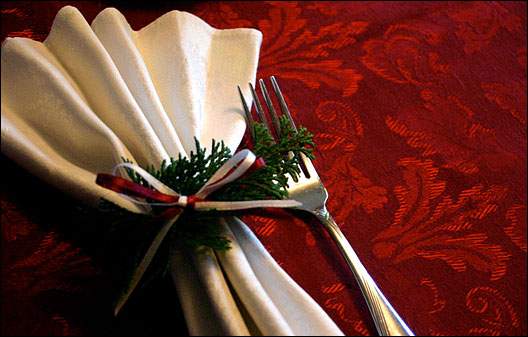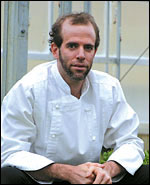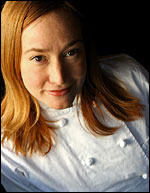
Chestnuts roasting on an open fire. Visions of sugar plums dancing. A partridge in a pear tree. The holiday season is rife with gastronomic traditions, as well as delectable memories of shared meals past. To get in the spirit, and perhaps encourage a few new traditions, we asked some all-star sustainability-minded chefs — including our own food columnists — to share their favorite holiday recipes. So grab a cup of organic ‘nog and dig in!
Dan Barber & Blue Hill’s Dairyless Fennel Soup
Deborah Madison’s Steamed Persimmon Pudding with Silky Persimmon Puree
Andrea Reusing’s Lion’s Head Meatballs
April McGreger’s Sweet Potato Angel Biscuits
Tom Philpott & Maverick Farms’ Holiday-Morning Cumin Biscuits
Isa Chandra Moskowitz’s Potato Latkes
Roz Cummins’ Warm Cider Caramel Sauce for Fresh Apple Slices
Monica Segovia-Welsh’s Chocolate Panforte
“With the last of the local fennel, don’t hide a thing by adding cream (or anything else).”

1 onion, chopped
3 small shallots, minced
3 1/2 cups diced fennel, white part only, reserving green fronds for garnish
1 apple, peeled and diced
Salt and ground black pepper
1 tablespoon fennel seeds, crushed
4 cups vegetable stock
1/2 teaspoon chopped thyme
Heat 1 tablespoon oil in a large saucepan, add the onion and shallots, and sweat until translucent. Add the fennel and apple, and season with salt and pepper. Cook for a few minutes before adding the fennel seeds and stock, bring to a boil, and simmer for 30 minutes. Add thyme and season to taste with salt and pepper.
Transfer to a blender and puree, adding the remaining 2 tablespoons olive oil. Return to saucepan and heat gently. Garnish with fennel fronds.
Dan Barber is an award-winning chef and co-owner of Blue Hill Restaurant in New York City and Blue Hill at Stone Barns in upstate New York, also home to the Stone Barns Center for Food & Agriculture.
“I have an affection for persimmon pudding because it was a favorite dish of my father’s, a Midwesterner who probably made it with native persimmons until he moved to California. Then it was Hachiyas. I can see the delight on his face upon pulling a pudding out of the oven. He used a recipe from the Joy of Cooking that was very buttery and moist and good — different than this steamed one which is also good, but more cakelike in texture. We had persimmon pudding as surely as others would have pumpkin pie.”
For steaming you will need a bowl or pudding mold with a 6- to 8-cup capacity. Serves six.

The Pudding
2 to 3 ripe Hachiya persimmons, enough for 1 cup puree
1 cup sugar
1 beaten egg
1 teaspoon vanilla
1/2 cup milk
1/2 teaspoon salt
1 cup flour
2 teaspoons baking soda
1 teaspoon cinnamon
1. Select a bowl for your pudding. It can be made of crockery, metal, glass, or it can be a proper pudding mold with a lid. Make sure it fits inside a large second pot or pan which can then be covered with a lid. You’ll also need to place a small inverted metal bowl in the pot for your mold to sit on so it won’t be directly over the heat.
2. Melt the butter. Generously brush some of it over the pudding dish and set aside the rest. Put the buttered mold on the inverted bowl. Bring a teakettle of water to a boil.
3. Halve the persimmons, pick out any seeds, then scrape the soft fruit from the skins. Puree, then measure 1 cup. Place the 1 cup of puree into a bowl with the remaining melted butter, sugar, egg, vanilla, milk, and salt. Whisk until well combined. Stir the dry ingredients together, then whisk them into the wet ingredients.
4. Pour the batter into the mold and cover with foil. Add the boiling water to come up 2/3 of the outsides of the mold, then cover the pot and cook gently for 1 1/2 hours. When the pudding is done, a cake tester inserted will come out clean. Remove it from the pot, then invert it onto a serving plate. If you’re not ready to serve, leave the mold resting on the pudding so that it will retain its heat. Whip the cream and make the persimmon puree (see below).
5. To serve, spoon a little of the whipped cream around the base of the pudding, along with a ribbon of the persimmon of puree. Or you can spoon drops of the puree into the cream, then fan them out with a tip of the knife. If you like, garnish the plate with pine or holly.
The Whipped Cream
1 cup powdered sugar
2 tablespoons melted butter
1/4 cup brandy
1 cup whipping cream
Beat the egg with the sugar, butter, and brandy. Whip the cream into soft peaks, then fold it into the remaining ingredients. If it separates before serving, a few strokes of the whisk will bring it back to a smooth, ivory sauce.
The Silky Persimmon Puree
1 tablespoon sugar or honey, to taste
1 teaspoon fresh lemon juice, to taste
Pinch of salt
Halve the persimmons, remove the seeds, then puree until smooth. Stir in the sugar, lemon juice, and a pinch of salt. Taste and add more sugar or lemon juice, if desired. Makes about 1 cup.
Deborah Madison is author of Local Flavors and Vegetarian Cooking for Everyone.
“We first served these braised meatballs at the restaurant as a way to use an overwhelming amount of whole hog after a miscalculation when ordering pigs. But I also really like it for a cozy holiday meal at home because the whole thing can be made day or two ahead, smells delicious while it reheats, and the cook can have her holiday, too.”
Makes about 45 meatballs, serving 8-10

For the meatballs
3/4 cup egg whites
1/3 cup, plus 1 tablespoon shao tsing wine or dry sherry
1/3 cup, plus 1 tablespoon soy sauce
1/4 cup white sugar
2 tablespoons toasted sesame oil
1 tablespoon, plus 1 teaspoon kosher salt
1 1/2 cups minced green onions, white and light green parts only
3 tablespoons finely minced ginger
For frying
Braising liquid and finishing the dish
15 dried black mushrooms, soaked in 2 cups of the chicken stock until soft, about one hour
1 thumb-sized piece of fresh ginger, peeled and sliced into thin matchsticks
1/2 cup shao tsing wine or dry sherry
1 cup dry white wine
1 1/2 teaspoons sugar
Salt to taste
1 tablespoon cornstarch, mixed with 1 tablespoon water to form a slurry
15-20 small baby bok choy, trimmed and cleaned
Sliced green onions for garnish
In a large bowl, briskly combine the first seven ingredients with a wooden spoon, stirring in one direction for about 3-5 minutes, until the fat is well integrated with the meat and other ingredients. Stir in the scallions and ginger and then form the mixture into two-ounce meatballs, about the size of large ping pong balls.
In a deep stockpot, add the vegetable oil to about 4 inches depth. Heat oil over medium high heat to 350 degrees. Fry the meatballs in small batches for about 2-3 minutes, until deep golden brown, but still raw in the center.
Preheat oven to 350 degrees.
While the meatballs are frying, start the braising liquid. Place a large clay casserole or other heavy casserole over low heat and add the chicken stock, dried mushrooms, ginger, shao tsing or sherry, wine, and sugar. Once the casserole begins to heat, increase the heat to medium, add salt to taste, and bring to a low simmer. Cook for about 15-20 minutes until the mushrooms have completely softened and the broth is fragrant and flavorful. Add the meatballs, return the broth to a simmer, cover the casserole, and place it in the oven to braise for about 15 more minutes, or until the meatballs are cooked through. Remove the casserole from the oven and then remove the black mushrooms from the broth. When they are cool enough to handle, trim their stems and discard them, then return the mushrooms to the casserole. Place the casserole over low heat on top of the stove, correct the seasoning, then add the slurry gradually while stirring. Add the bok choy and cook until its color has intensified to a deep, bright green and it is tender but still slightly crisp.
Garnish with green onions and serve at the table from the casserole along with steamed jasmine rice.
Andrea Reusing is chef and owner of the Chapel Hill, N.C.-based restaurant Lantern.
“Angel biscuits are a classic Southern cocktail nibble. You can make the dough and simply keep it in the refrigerator for up to a week, rendering it the perfect make-ahead bread. I add sweet potato to my version for a festive touch, because they are such an important crop to my Vardaman, Miss., home, and because they go so well with ham.”
Yield: 30 biscuits

1/4 cup warm water (105 to 115 degrees)
3 1/2 cups all-purpose flour, sifted
1 tablespoon baking powder
1 teaspoon baking soda
3 tablespoons brown sugar
1 tablespoon salt
1/2 teaspoon ground ginger
Pinch of fresh grated nutmeg
1/2 cup pastured lard or non-hydrogenated vegetable shortening
1 1/2 cups cool mashed sweet potato (about 2 medium-sized sweet potatoes)
1 3/4-2 cups very cold buttermilk
Zest of one lemon, preferably organic
3 tablespoons melted butter
Prick the washed sweet potatoes with a fork and bake them at 400 F for about one hour, until very soft. When cool, peel, mash, and measure 1 1/2 cups of puree. Mix the puree with 1 3/4 cups of buttermilk and the lemon zest and set aside in the refrigerator.
In a small bowl, dissolve the yeast in the warm water with the sugar.
Sift together the flour, baking powder, baking soda, ground ginger, nutmeg, and salt in a mixing bowl. Cut in the lard or shortening with a pastry blender, a fork, or your fingers until you have clumps the size of peas. Stir in the buttermilk-sweet potato mixture and the yeast mixture and mix lightly until the mixture forms a soft dough. You may need to add up to 1/4 cup more buttermilk to get the dough to come together.
Place dough in a large oiled bowl or container, cover, and refrigerate 8-36 hours.
Turn the dough out onto a lightly floured surface and roll out 1/2-inch thick. Cut with a 2-inch biscuit cutter and place biscuits 1 inch apart on a parchment-lined and lightly buttered baking sheet. Allow to rise at room temperature approximately 1 hour until puffy. Preheat the oven 400 F.
Brush tops with melted butter and bake 15-18 minutes, until lightly browned. These can be baked several hours ahead if desired. Store covered at room temperature. Reheat before serving if desired.
Tuck slithers of baked, country, or prosciutto ham inside these biscuits, pile them high on a platter, and serve with mustard or chutney.
April McGreger is the proprietor of Farmer’s Daughter, a farm-driven artisan food business in Carrboro, N.C., and writes a column for Grist of the same name. She is a leader in her local Slow Food convivium, where she is known to curate field pea tastings and write for the Slow Food Triangle blog. When not in the kitchen, she can usually be found at her local community garden or singing and playing the tenor banjo with her husband Phil.
“When some close friends visited Maverick Farms a few years ago, I wanted their last breakfast to be memorable. Something made me spike the biscuit batter with lashings of ground cumin and chile pepper — and the result rocked. Now we serve these on special mornings.”
1 cup whole-wheat pastry flour
1 teaspoon baking powder
1/2 teaspoon baking soda
1/2 teaspoon sea salt
1 tablespoon ground cumin, freshly ground if possible
A generous grind (or three) of black pepper
optional: chile flakes, to taste; or chopped fresh chile pepper, to taste (note: Do it!)
6 tablespoons butter, cold
1 cup buttermilk (see note below)
1 cup grated cheddar cheese
Makes 12-16 biscuits
Preheat oven to 450 F.
Combine all dry ingredients (up to and including optional chile flakes) in a large bowl. Whisk to combine. Cut butter into small chunks. Add to bowl and cut into dry ingredients with two forks, until it resembles coarse cornmeal. Gently stir in buttermilk and cheese.
Dust a clean work surface with flour. Dump dough onto surface, pat down a little, and lightly dust with flour. Using a floured rolling pin, gently roll out to 1 inch think. Cut dough into rounds (I use an upside-down teacup), placing on baking sheet about an inch apart.
Bake until golden brown, 15 or so minutes.
Note on buttermilk: To substitute regular whole milk for buttermilk — as we often do at Maverick Farms — add a tablespoon of lemon juice or apple cider vinegar to a little bit less than a cup of milk. Let sit for a few minutes, and it will sour.
North Carolina-based Tom Philpott is Grist’s food editor and co-founder of Maverick Farms.
“When the cold weather kicks in there is nothing as comforting as potatoes, and if you need an excuse to eat fried food, this is it. Latkes have always tasted like home to me. It’s funny, because although I grew up eating them, my family never actually made them. It was only when I was a teenager that I came up with this recipe that I began to serve at family functions. Serve with plenty of homemade applesauce.”
Makes about 18

1 small yellow onion, peeled
1/4 cup potato or corn starch
1 teaspoon salt, plus extra for sprinkling
1/2 teaspoon ground black pepper
2 cups matzo meal
Lots of vegetable oil for frying
If using a food processor, use the grating blade to shred the potatoes and the onion. If shredding by hand, use a grater to shred all the potatoes. Dice the onion as finely as possible.
Have ready brown paper shopping bags or paper towels for draining the oil from the latkes. You may also want to have the oven on at 200 F to keep the latkes warm until you’re ready to serve. If serving immediately, just have a baking pan covered with tin foil ready to keep the finished ones warm after they’ve been drained.
In a large mixing bowl, using a wooden spoon or your hands (I use my hands; it’s faster) mix the potatoes and onions with the potato starch until the potatoes have released some moisture and the cornstarch is dissolved, about 2 minutes.
Add the salt and pepper to combine. Add the matzo meal and mix well. Set aside for about 10 minutes. The mixture should get liquidy but sticky.
In the meantime, preheat a large — preferably cast iron, but definitely non-stick — skillet over medium high heat. Add about 1/4 inch layer of vegetable oil to the pan. The oil is hot enough when you drop a bit of batter in and bubbles rapidly form around it. If it immediately smokes, the heat is too high and you should lower it a bit. If the bubbles are really lazy, give it a few more minutes or turn the heat up a bit.
With wet hands (so that the mixture doesn’t stick) roll into small golf ball-sized balls. Flatten into thin round patties. I do about four to six at a time. Fry on one side for about 4 minutes, until golden brown. Flip over and fry for another 3 minutes.
Transfer to the paper towels and proceed with the remaining latkes. Once latkes have drained on both sides, place in a baking pan to keep warm.
Isa Chandra Moskowitz is the creator and co-host of the Post-Punk Kitchen, a public-access vegan cooking show in New York City, and co-author of Veganomicon: The Ultimate Vegan Cookbook.
“I like to serve this at the end of a holiday meal, because it is light but satisfying. The crisp, cool apple slices contrast nicely with the warm pool of cider-based caramel. I hope that you all enjoy a peaceful holiday surrounded by loved ones.”
Makes enough to drizzle over 8 sliced apples
I think it’s fun to have a variety of apples to try: Cortlands for their juicy white flesh and ultimate “crisp apple” flavor, Granny Smiths (scroll down to see a picture of the actual Granny Smith) for their signature tart/sour bite and firm texture, and some Golden Delicious for their mild-mannered flavor (there’s almost a banana-pear-honeysuckle thing going on in some of them). Share some of the apple that you cut in exchange for some of the apples that were cut by the others at the table.
I rarely use corn syrup, but when I do I buy organic corn syrup so that I am not unwittingly supporting the use of GMO corn.
1/2 cup organic corn syrup
1/2 cup cider, apple juice, or water
1 teaspoon genuine vanilla extract
1/4 teaspoon cinnamon
1/3 cup heavy cream
8 apples
Stir the sugar, corn syrup, water or cider, vanilla, and cinnamon together in a medium-size pot until well blended. Let the mixture cook, without stirring, over high heat until it reaches the hard-crack candy stage (300 to 310 degrees).
Take the pot off the stove the very minute the syrup reaches the hard-crack stage, otherwise the syrup will burn. (Seriously. You cannot let your guard down about this!) Let cool for 5 minutes.
Add the heavy cream and stir until combined. Serve over freshly cut apple slices.
Roz Cummins is a Boston-based food writer and former Grist columnist who is interested in figuring out how to shop, cook, and eat in a sustainable way on a day-to-day basis without going crazy, i.e. the intersection where activism meets flavor and budget constraints at the end of a busy day.
“I started making a version of chocolate panforte when I worked at a small bakery in northern Wisconsin. I became addicted to the chocolate-honey-spice combination so much that it has become a yearly winter tradition with my family. The variations of nuts and fruits are endless, and I look forward to using what’s local to make it seem ‘new’ every year.”
4 oz. dried black mission figs, destemmed and quartered
4 oz. dried sour cherries
2 oz. crystallized ginger, diced
2 1/2 oz. unsweetened Scharffenberger chocolate
1 oz. bittersweet Scharffenberger chocolate
1 teaspoon ground cinnamon
1 teaspoon ground cardamom
1/2 teaspoon each, ground black and pink peppercorns
1/4 teaspoon ground coriander
1/4 teaspoon nutmeg
1/4 cup dark rum
3/4 cup Sourwood honey
3/4 cup lightly packed brown sugar
1 vanilla bean pod, seeds scraped
1 cup all-purpose flour, sifted
Preheat oven to 350 F. Put pecans on a sheet pan and lightly toast for 10-12 minutes. Set aside to cool.
Butter the bottom and sides of a 9-inch springform pan, line the bottom and sides with parchment, and butter the paper.
In a medium bowl, combine the cooled nuts, dried fruits, chocolate, spices, and rum.
In a saucepan, combine the honey, brown sugar, and vanilla bean seeds. Bring it to a rolling boil and cook for one minute. Take it off the heat and immediately pour onto the nut-chocolate mixture. Gently stir to combine, making sure all the chocolate is melted.
Add the flour and gently fold it together. It will be smooth, glossy, and very sticky. Immediately pour it into the prepared springform pan and spread it evenly. It’s helpful at this point to dip your fingertips into cold water and press the dough evenly into the pan.
Bake it for 40-50 minutes until it bubbles in the middle and sets. Remove from the oven and cool on a wire rack completely. Release springform and remove pan bottom. Peel off the parchment.
You can leave it plain or dust the top with a combination of powdered sugar and cocoa and then brush away the extra.
Cut into 16-20 thin slices and serve or keep wrapped airtight for up to a month.
Monica Segovia-Welsh is the pastry chef at the Chapel Hill, N.C.-based restaurant Lantern.


